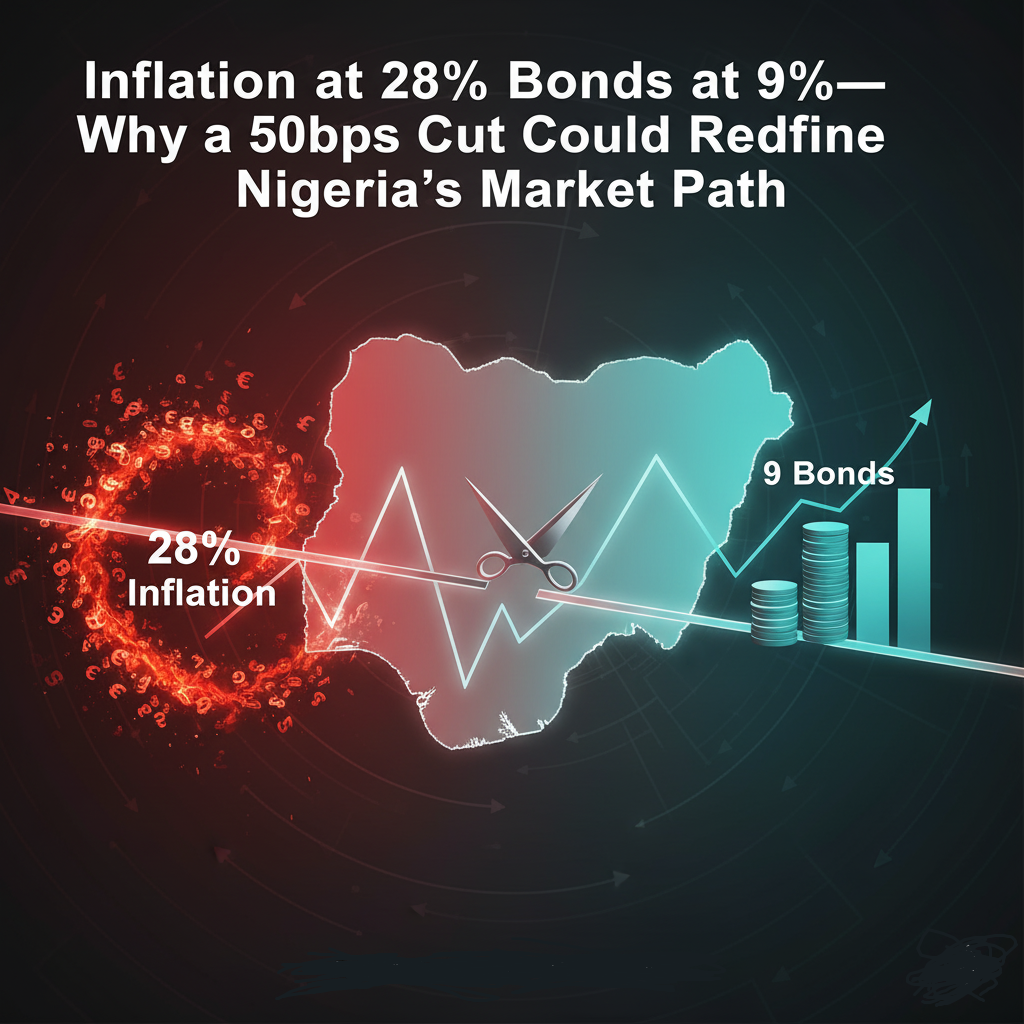Inflation at 28%, Bonds at 9%—Why a 50bps Cut Could Redefine Nigeria’s Market Path
Nigeria’s CBN cuts rates 50bps to 27%, its first since 2020. With inflation at 28% and Eurobond yields near 9%, the move signals a cautious pivot to growth. Will banks like ZENITHBANK, GTCO, and ACCESSCORP pass it on—or will FX fragility erase the gains?

Nigeria’s Central Bank has taken a decisive step away from its long cycle of monetary tightening by cutting the benchmark rate by 50 basis points to 27 percent, the first reduction since 2020. For observers of Africa’s largest economy, the number itself is less important than the signal it carries: a willingness to shift from crisis-management mode toward cautiously supporting growth and credit expansion. The timing, rationale, and credibility of this move are central to understanding how it will shape investor sentiment and domestic business conditions.
The last major decision of this scale came in March 2020 at the onset of the COVID-19 crisis, when the Central Bank slashed rates to buffer the economy against collapsing oil prices and a sharp contraction in GDP. That emergency easing failed to unlock significant credit expansion. Lending remained constrained by structural bottlenecks in Nigeria’s banking system and by double-digit inflation that quickly eroded any benefit from lower nominal rates. Within a year, inflationary pressures forced the Monetary Policy Committee back into tightening, and over the following three years, the benchmark rate climbed steadily to one of the highest in the world. The result was limited credit growth, negative real interest rates, and an economy that recovered only modestly, with GDP growth averaging 3 percent annually against a population expanding at 2.5 percent.
This history explains why the present cut is viewed more as a policy signal than an immediate game-changer. Inflation, which peaked above 30 percent earlier in 2024, has eased to about 28 percent, giving the Central Bank room to argue that the worst price instability has passed. Yet real lending rates remain deeply negative, and banks, cautious after years of volatility, are unlikely to pass on the full benefit of a half-point reduction. Businesses still face borrowing costs above 30 percent, which constrains investment appetite, especially for SMEs that depend on credit. Nigerian banking stocks such as Zenith Bank (NGX: ZENITHBANK), Access Holdings (NGX: ACCESSCORP), and GTCO (NGX: GTCO) may see sentiment gains, but the transmission into actual loan growth will take time.
Still, the cut carries weight. It marks an inflection in the Central Bank’s narrative, suggesting a pivot from singular inflation targeting toward a dual emphasis on price stability and growth. For global investors, the move positions Nigeria alongside a broader African trend where central banks, after prolonged tightening, are recalibrating. Ghana’s central bank has eased its Monetary Policy Rate from 30% to 29% as inflation moderated below 24%, while Kenya has held steady at 13% and South Africa at 8.25%. Compared with peers, Nigeria remains an outlier with the highest nominal rate in Sub-Saharan Africa, underscoring how limited its room for maneuver is.
The real test lies in transmission. If inflation continues its downward path into the low 20s by mid-2026, the Central Bank may pursue further measured cuts, potentially creating conditions for genuine credit growth and a revival of private investment. In that optimistic scenario, Nigeria could see incremental output gains in manufacturing, agriculture, and consumer-facing sectors, while equities — reflected in the NGX All-Share Index, up 35% YTD — might benefit from stronger earnings prospects. Conversely, if food inflation spikes again or FX instability resurfaces, the Central Bank could be forced to reverse course, undermining fragile credibility. The naira, which has traded near ₦1,450 per USD in parallel markets, remains vulnerable, and any renewed volatility could neutralize the easing effect.
The context of fiscal fragility adds further complexity. Nigeria’s Eurobond yields (NG 2032s) hover near 9 percent, reflecting persistent risk premiums tied to debt sustainability and currency pressures. For comparison, Ghana’s 2032 bonds yield 10.8% after restructuring, while South Africa’s 2032s trade closer to 6%. A premature easing cycle could aggravate concerns about Nigeria’s debt profile, while cautious and credible steps could reassure markets that Abuja is balancing growth with discipline. Frontier market benchmarks such as the MSCI Frontier Markets Index (NYSE: FM) will be watching whether Nigeria’s easing cycle attracts portfolio inflows or triggers capital flight.
Whether the signal translates into real change depends on the durability of disinflation and the ability of banks to expand credit responsibly. The 2020 episode reminds us that lower policy rates do not guarantee stronger growth in the absence of structural reforms. This time, the CBN will be judged on whether it can sustain a credible easing path without triggering fresh inflation, and on whether it can align monetary policy with fiscal consolidation and industrial reforms. For now, the 50 basis point cut is not about easing the cost of capital overnight but about sending a carefully measured message: inflation is no longer the sole battlefront, growth is back on the agenda, and Nigeria is cautiously joining the global pivot toward more accommodative policy.





